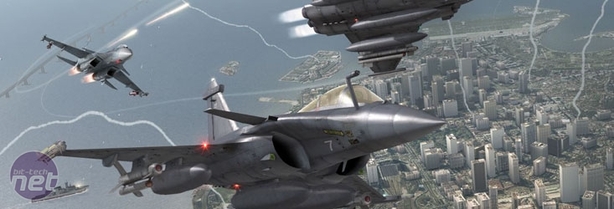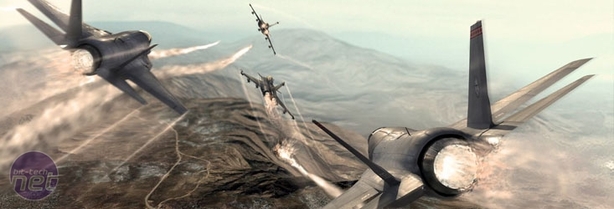Flying High
The most forthright of these technical aids available to players is the addition of a 3D interception guide which pilots can summon up before them. If you’re having trouble keeping a bead on a particularly erratic foe then you can pull up the interception tunnel and it’ll try to guide you.How it does this is by making a series of blue triangles appear in front of you, each one a checkpoint for you to fly through. Weave your way through enough and you should come out directly behind your foe, your missiles already locked on. Get the path wrong however and you’ll just end up twirling through the air blindly.
Unfortunately though, while the interception guide is pretty prominent, it’s also a bit useless most of the time. You can easily switch through targets with the touch of a button as it is and there’s always a marker on screen that tells you where and how far away the enemy is. You may as well just follow that.
Where these free-floating checkpoints become really useful is when an enemy gets a missile lock on you, at which point you can summon a set of checkpoints that’ll help you dodge away from the incoming explosive. We’d love to say that we found this feature a lot more useful, but nobody ever really got a lock on us for very long, to be honest.
Not that they couldn’t keep a bead on us because we were too good though, we just kept crashing into the ground.
Likewise, we weren’t crashing into the ground thanks to a lack of ability, we were just struggling to keep control of the monstrously awesome control set up that Ubisoft had kindly arranged for us to demonstrate how cool HAWX can be.
Officially then: if you’ve got the hardware then Tom Clancy’s HAWX will redefine what you want from an immersive game experience. HAWX can have full multi-monitor support through a Matrox Triplehead2Go, it can be used with pretty much and set of high-end flight sticks, it has DirectX 10.1 content and it fully supports AMBX on top of all that.
The circumstances we found ourselves playing the game in were thus then; with three 30” screens totally filling our periphery vision, two colossal joysticks controlling the plane and a series of lights and fans around the room. If we rolled to our left then lights on the right of the screen would hue to blue as the AMBX system met the sky. When we dropped the hammer then fans on the desktop would blow our hair (and pathetic beards) back to simulate the thrust. Between our legs a multi-CPU system with four graphics cards thrummed like some sort of satanic engine.
It was, quite simply, glorious. We loved every minute of it and it was especially gratifying to see that Ubisoft has made the most of the PC platform for the PC version of the game. By comparison, the console versions which were also on hand during our hands-on time simply had standard controllers and headsets. It really is true what they say; once you go phat, you never want to go back.
As we said at the start of this preview, flight simulations aren’t just in decline but have apparently become properly extinct in the eyes of many. After seeing HAWX though, we’re not so sure that the issue is as black and white as that – it seems that flight sims may have just evolved a bit.
HAWX is no simulator, that much is clear. There’s no taxiing off the runway and you don’t even have an option to land your jet either. One thing that HAWX, in its many-splendored set up, managed to simulate perfectly though was a sensation of speed and mid-air grace. If, in order to bring that sensation to the market, then Ubisoft has had to drop the intricacies of mechanical flight in favour of more explosions then we don’t think that’s an utterly bad thing.
Tom Clancy’s HAWX is out on consoles now, published by Ubisoft. The PC version of the game will be out on March 20th.

MSI MPG Velox 100R Chassis Review
October 14 2021 | 15:04












Want to comment? Please log in.